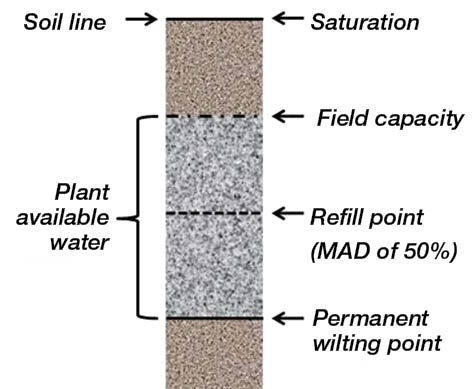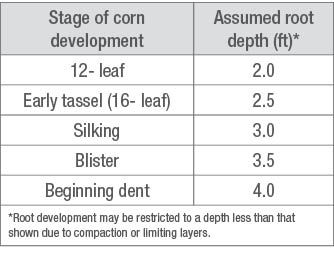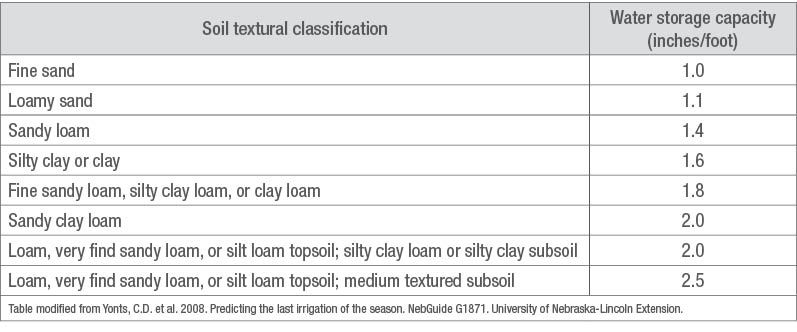7 MIN READ
Scheduling Irrigation for Corn
May 27, 2025
Irrigation scheduling is a planning, measuring, and decision-making process for determining when, and how much irrigation water should be applied. Decisions are based largely on the available water supply, the soil’s water holding capacity and infiltration rate, and crop needs.1 Irrigation scheduling involves tracking water withdrawals and water inputs to monitor soil water content. Irrigation is applied when soil water content reaches a threshold before plants are stressed. Water withdrawals are determined from weather-based estimates of crop water use and/or direct measurements of changes in soil water. Water inputs are applied with consideration for stored soil moisture plus irrigation and precipitation.

The following terms are important to understand any irrigation scheduling discussion:
- Evapotranspiration (ET) is a measure of crop water use that combines the loss of soil water through evaporation (E) from the soil and leaf surfaces with transpiration (T), which is the movement of water from the soil through stems and leaves to the atmosphere. It is estimated that 70 to 80% of crop water use is due to transpiration.1 Several factors influence ET, including crop growth stage and weather conditions. Transpiration rates increase as a plant becomes larger due increasing leaf area and will typically peak during reproductive growth stages. The ability of the atmosphere to evaporate water is also a major driving force for ET as solar radiation, air temperature, relative humidity and wind all play a role in this process.
- Saturation occurs when the pore space in a soil is completely filled with water.2
- Field capacity is the water content of a soil that can be held against gravity after it has been thoroughly wetted by rainfall or irrigation and then allowed to drain for at least 48 hours.
- Permanent wilting point is the soil water content at which a plant can no longer extract water because it is held too tightly by to the soil particles.
- Plant available water is the water held by the soil between field capacity and the permanent wilting point. The amount of plant available water differs greatly by soil texture.
- Maximum allowable depletion (MAD), also known as management allowed depletion, is the soil water level at which plant stress (and potential yield losses) may begin to occur. This is the threshold that indicates when irrigation should be applied. The MAD will vary by crop species and crop developmental stage.
Monitoring Soil Moisture Content
Soil moisture levels are used to determine when irrigation should be applied. The rate of water loss from evapotranspiration (ET) and inputs from precipitation will affect soil moisture levels.
Soil moisture is tracked using daily crop ET estimates and/or soil moisture measurements from soil sensors or probes. Many tools are available for estimating soil moisture and daily crop ET, ranging from filling in a spreadsheet to using sophisticated web-based applications that have access to soil databases and weather networks. Daily crop ET estimates are made in relation to local weather conditions and crop developmental stage. Actual ET can vary with higher-than-normal ET on hot windy days and lower-than-normal ET on cool cloudy days. Soil moisture sensors placed throughout the crop root zone, ideally at 1-, 2-, and 3-foot depths, can provide the farmer with a direct measure of changes in soil water content. The sensors should be located within the crop row and not placed into low-lying areas. Soil moisture can be tracked by measuring water inputs from precipitation and irrigation and estimating losses from evapotranspiration (ET). Hand-held soil probes can also be used along with the feel method to estimate soil moisture in each foot of soil depth.
Using Evapotranspiration (ET) Estimates and the Maximum Allowable Depletion (MAD) to Determine When and How Much to Irrigate
The amount of water to apply in an irrigation will depend on the:
- Crop rooting depth, which is related to plant growth stage (Table 1). Irrigation should be targeted to the depth of the crop roots. Irrigation that penetrates beyond the crop root depth may not be absorbed by the plants and could be wasted.
- Water holding capacity of the soil, which is related to soil type (Table 2). Irrigation that exceeds the water holding capacity of the soil may be lost to deep percolation and/or runoff.
- Efficiency of the irrigation system, which is the percent of the total output that makes its way to the root zone where plants can absorb it versus loss to evaporation, deep percolation, and runoff (Table 3).
Table 1. Average root depth of corn at various growth stages.3

Table 2. Water holding capacity of different soil types.

Table 3. Potential application efficiencies (AE) for well-designed and well-managed irrigation systems.4

By using these three variables (crop rooting depth, water holding capacity, and irrigation system efficiency) farmers can calculate the maximum amount of water to apply at one time if the soil moisture level is depleted.
Ideally, irrigation is applied before the soil water content drops below the maximum allowable depletion.
Determining the Maximum Allowable Depletion (MAD).
Corn can use 50% of the available water stored in the soil before plant stress begins.3 Information on the root depth of the crop (Table 1), the water holding capacity of the soil (Table 2), and the efficiency of the irrigation system (Table 3) can be used to help determine how many inches of water must be depleted to reach a MAD of 50%. For the example below we will determine the MAD for corn at the silk and tassel growth stage in a sandy loam soil.
- For corn at silking, the rooting depth is approximately three feet.3
- At three feet, a sandy loam soil has a plant available water holding capacity of 4.2 inches (1.4 inches of water per foot of soil depth x 3.0 feet root depth).
- Corn can use only 50% of that capacity before stress will begin, so the MAD would be 2.1 inches of water (4.2 inches x 50%).
- To prevent crop stress, irrigation will need to be applied before the corn crop has used 2.1 inches of water.
Using Daily ET Estimates to Determine When Soil Water Will Reach the MAD.
- In the above example, with a MAD of 50%, the silking corn crop has an allowance of 2.1 inches of stored soil water at field capacity in sandy loam soil.
- If the ET rate is 0.32 inches per day, there should be ample stored soil water for approximately 6.5 days (2.1 inches ÷ 0.32 inches per day).
ET values are dependent on climate and vary from location to location. Always obtain ET estimates from local sources for greatest accuracy. Follow recommendations from your local Extension service or technical representatives.
Consider the Efficiency of the Irrigation System.
- See Table 3 for efficiency of various irrigation systems. For this example, we will assume that a center pivot irrigation system has 80% efficiency and 2.1 inches of water is available to the corn crop when field capacity is reached. If the farmer applied 2.1 inches of water, only 1.7 inches of the irrigation water would be available for plant use. (2.1 inches of water x 80%).
- Accounting for the 20% loss of efficiency of the irrigation system, possibly due to factors such as spray droplet evaporation, wind drift, or evaporation of free water from the crop canopy, 2.6 inches would need to be pumped from a water source to deliver a net of 2.1 inches (2.1 inches of water needed for plants ÷ 80%) to reach field capacity.
- Continuing with the example of using a center pivot, keep mind the amount of time required for the system to make one revolution. If, for example, it might take 72 hours (3 days) for one trip around the field, and there are 6.5 days of soil moisture remaining as stated above, the grower will need to apply a net of just over 1 inch of water per revolution to meet ET demands. Similar considerations need to be taken into consideration when irrigating via furrow irrigation systems. Keeping up with peak ET demand at growth stages such as pollination may or may not be possible depending on the capacity of the system (gallons per minute) to deliver the required amount of water in a timely manner, as well as the soil’s infiltration capacity to absorb that amount of water without runoff occurring.
- If rain is in the forecast, a farmer would not necessarily need to apply the full amount of irrigation needed to bring the water content of the soil back to field capacity. This depends on the regional climate. In regions, with more extreme arid and semi-arid climates where rain is unlikely, it may be best to fill the soil to field capacity. In other regions, leaving room in the soil profile for a precipitation event is a wise way to save money on irrigation cost
Sources
1 Kranz, W.L., Irmak, S., van Donk, S.J., Yonts, C.D., and Martin, D.L. 2008. Irrigation management for corn. NebGuide G1850. University of Nebraska-Lincoln Extension. https://extensionpubs.unl.edu/publication/g1850/irrigation-management-for-corn.
2 Peterson, J. M., Christiansen, A.P., Dierberger, B.S., Ferguson, R.B., Frank, K.D., Hay, P.C., Hergert, G.W., Lewis, D.T., Jones, A.J, et al. 1999. Soils. Plant & Soil Sciences eLibrary. University of Nebraska Cooperative Extension Institute of Agriculture and Natural Resources. https://passel2.unl.edu/view/lesson/0cff7943f577/10.
3 Rhoads, F.M. and Yonts, C.D. 2013. Irrigation scheduling for corn-why and how. NCH-20. In National Corn Handbook. University of Wisconsin Extension.
4 Irmak, S., Odhiambo, L.O., Kranz, W.L., and Eisenhauer, D.E. 2011. Irrigation efficiency and uniformity and crop water use efficiency. Publication EC732. University of Nebraska-Lincoln Extension. https://extensionpubs.unl.edu/publication/ec732/irrigation-efficiency-and-uniformity-and-crop-water-use-efficiency.
Andales, A.A. and Chavez, J.L. 2011. ET- based irrigation scheduling. Proceedings of the 2011 CPIC. Burlington, Colorado, Feb 22-23.
Web sources verified 05/14/2025. 1221_75496